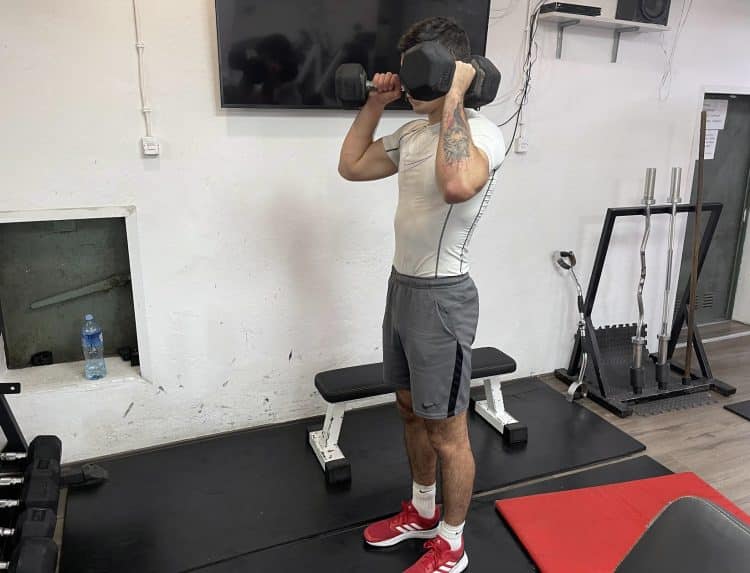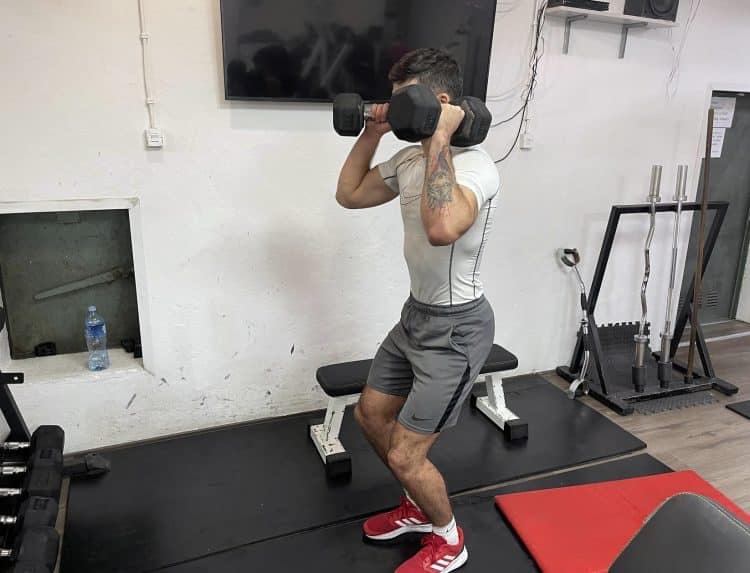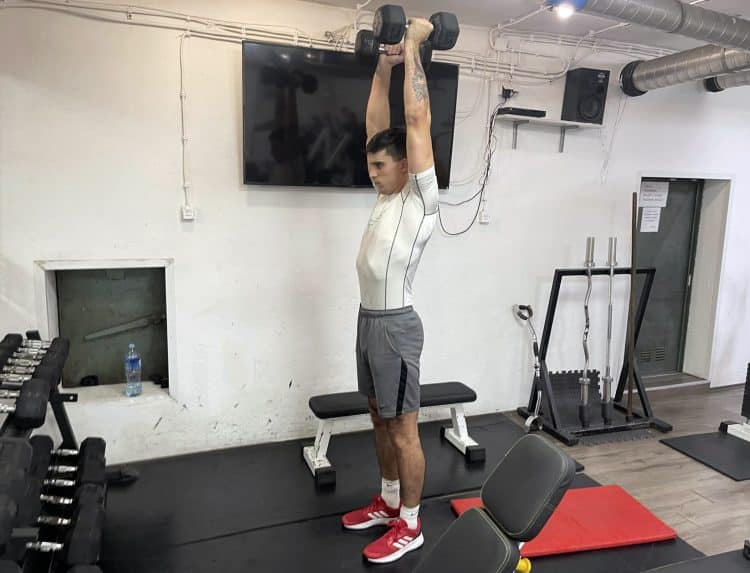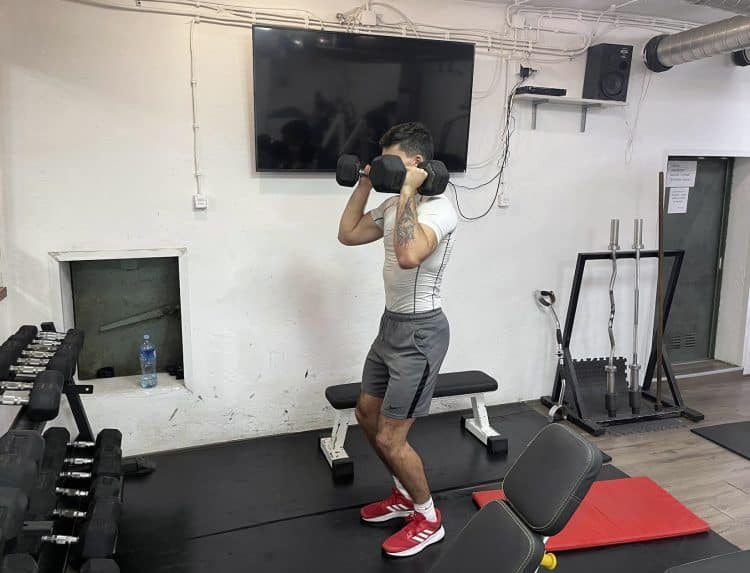There are more overhead press exercises than most lifters will ever bother to memorize. The dumbbell push press is an excellent barbell overhead press alternative. A study by the Journal of Strength and Conditioning Research compared “the effect of performing upper-body resistance exercises with dumbbells versus barbells and standing versus seated.” It concluded that standing shoulder presses demonstrated the highest neuromuscular activity of the deltoid muscles due to their stability requirements. (1)
The dumbbell push press is an excellent lift to have in your exercise arsenal. I personally can lift heavier loads on this exercise than military or machine presses as it allows lower body engagement. The extra poundage can potentially result in superior strength gains.
I put together this dumbbell push press guide to help you build shoulder strength, muscle mass, and stability. Using the correct exercise form will also reduce the risk of potential injuries.
A Step-By-Step Dumbbell Push Press Guide
Besides strength and muscle gains, dumbbell push presses can help build explosiveness. Based on my experience with this push press variation, I suggest starting with lighter weights to drill the movement mechanics.
Also, you must practice caution while performing this lift. Don’t use more weight than you can handle safely. (2)
Step One — Get into the Starting Position
Pick two dumbbells of appropriate weight. Stand upright with your feet shoulder-width apart and hold the dumbbells against your thighs with a neutral grip. Lift the dumbbells to shoulder level by flexing your elbows.
Level Up Your Fitness: Join our 💪 strong community in Fitness Volt Newsletter. Get daily inspiration, expert-backed workouts, nutrition tips, the latest in strength sports, and the support you need to reach your goals. Subscribe for free!
Pro Tip: Before you even pick up the dumbbells, take a moment to focus on your breathing. A deep inhale and a slow exhale can help you mentally prepare and improve your overall stability. Trust me; it makes a noticeable difference.
Step Two — Slightly Flex Your Hips, Knees, and Ankles
After stepping into the starting position, it’s time to create momentum before pushing both dumbbells toward the ceiling. Slightly bend your hips, knees, and ankles simultaneously. Keep your core braced as you dip your legs.
Pro Tip: One thing I’ve found incredibly useful is to visualize the lift before you start moving. Imagine the smooth, explosive motion as you flex your hips, knees, and ankles. This mental rehearsal can help you execute the lift with precision and power.
Step Three — Initiate the Concentric Phase
The third Newton’s law states that every action has an equal and opposite reaction. When you flex your hips, knees, and ankles, you elongate your working muscles, building the so-called “free energy” in your tendons, especially the Achilles tendon.
So, when you achieve the bottom position after you flex your ankles, knees, and hips, it’s time for an equal or potentially much stronger extension. Forcefully extend your ankles, knees, and hips, and use that momentum to push both dumbbells toward the ceiling.
As you extend your ankles, knees, and hips, simultaneously flex your shoulders and extend your elbows to move both dumbbells in the overhead position. The top position is achieved when your elbows are locked out.
Pro Tip: As you start extending your hips, knees, and ankles, think about driving through your mid-foot. This cue can help you engage the lower body effectively and transfer that energy into pushing the dumbbells overhead, leading to a smoother lift.
Step Four — Initiate the Eccentric Phase
Now that both dumbbells are in the top position, it’s time to begin the lowering or eccentric phase. Slowly and with utmost control, lower both dumbbells to the starting position by flexing your elbows and extending your shoulders. Position the dumbbell over your shoulders at the bottom if your mobility allows it. This completes one rep, and you can proceed with the next one.
However, there are two ways to execute the eccentric phase. First, quickly lower the dumbbells to your shoulders while bending your hips, knees, and ankles to absorb the landing impact. The second method is described above, where more emphasis is put on the slow eccentrics. Choose one of these two options according to your goals.
Pro Tip: For the eccentric phase, I’ve discovered that controlling the descent not only helps with muscle development but also reduces the risk of injury. So, focus on a slow and controlled lowering motion. It might not feel as exciting as lifting, but it pays off in terms of muscle growth and joint health.
Dumbbell Push Press Muscles Worked
While the dumbbell push presses work similar muscle groups as the barbell variation, there are a few differences. Below is a breakdown of the primary and secondary muscles worked during this exercise:
- Shoulders (Deltoids): The dumbbell push press biases the front deltoids.
- Triceps Brachii: The triceps play a vital role in elbow extension to get the dumbbells in the overhead position.
- Legs (Quadriceps): All four quad muscles are engaged in the dip. As told before, they are primarily responsible for generating initial reactive force, which propels both dumbbells and gives them the necessary starting velocity.
- Core (Abdominals and Obliques): All the primary abdominal muscles, including rectus abdominis, obliques, and transversus abdominis, work together to stabilize the core and maintain balance and an upright torso throughout the movement.
However, these muscles can’t complete the movement efficiently without secondary muscle involvement, so below are those as well:
- Upper chest (pectoralis major)
- Lower back (erector spinae)
- Glutes and hamstrings
- Calves (gastrocnemius and soleus)
Benefits of Dumbbell Push Presses
Based on my extensive research and personal experience, and after consulting some experts in the field, I curated the list of the most notable dumbbell push press benefits, which you can check below:
Increased Upper Body Strength
There are four primary upper body movement patterns, including vertical push, vertical pull, horizontal push, and horizontal pull. Performing exercises in whichever pattern will increase your upper body strength and muscle mass.
Since the dumbbell push press falls under the vertical push category, it will increase your upper body strength, which includes the triceps brachii, pectoralis major, and front deltoid.
Improved Shoulder Stability
Free weights, in general, are excellent for developing stabilizer muscle function and strength. Even though the barbell is a free weight, dumbbells will yield much better results in terms of stabilizer muscle development.
Level Up Your Fitness: Join our 💪 strong community in Fitness Volt Newsletter. Get daily inspiration, expert-backed workouts, nutrition tips, the latest in strength sports, and the support you need to reach your goals. Subscribe for free!
You’ve probably heard people tell you to stay under 80% of your barbell overhead press 1RM when using dumbbells. Dumbbells require greater stabilizer muscle engagement, making the lift more demanding.
Enhanced Power Output
Dumbbell push presses will likely increase your overall power output. However, the barbell variation is much better for building strength since it provides more stability. Also, you will need to nail the rep range, overall rest intervals, and workout volume for the power development.
Generally, I recommend performing between one to six reps with 60-80% of your 1RM and resting as much as you need between the sets until you fully recover and can perform the exercise with the same initial effort. The recovery usually takes at most five minutes, but remember that this number can vary for each individual.
Functional Strength
Free weights are functional; machines aren’t. We can debate this for five days straight, but that is just a fact. However, what most people get wrong is believing that you shouldn’t implement any of the machine-based lifts in your workout program.
You should mix free weights and machines to get the best possible result regarding strength, stabilizer development, and muscle hypertrophy. Just remember to first perform the free weight exercises and then machine-based ones because free weights require more effort, energy, and overall concentration to complete (higher demand on the central nervous system).
Dumbbell Push Press Alternatives and Variations
Implementing push press variations and alternatives has proven beneficial for improving your overall lifting performance for particular movement patterns, in this case, vertical push. (3). Here are the best dumbbell push press alternatives and variations:
Barbell Push Press
The barbell push press is the most suitable lift for those who want to lift heavy and develop upper body strength and explosiveness.
Steps:
- Start by placing the barbell on the squat rack at shoulder height.
- Load an appropriate weight.
- Hold the barbell with a shoulder-wide overhand grip and let the barbell rest on your shoulders in the front rack position.
- Unrack the barbell and take a step back.
- Assume a hip-width or a slightly wider stance.
- Start the exercise by bending your hips, knees, and ankles.
- Quickly reverse the motion by initiating the triple extension to propel the barbell toward the ceiling.
- Fully extend your shoulders at the top of the ROM.
- Reverse the motion to return the barbell to the starting position.
- Repeat for recommended reps.
Pro Tip: Based on my experience, focus on driving through your hips as you begin the concentric phase. It not only adds extra power but also helps you maintain better control when lifting heavy weights.
Kettlebell Push Press
The kettlebell push press is a little more functional than the dumbbell push press. However, the differences aren’t too substantial, so strength and hypertrophy-wise, you are good to go with both versions.
Steps:
- Pick two kettlebells of an appropriate weight.
- Stand erect with a hip-width stance.
- Lift both kettlebells to the shoulder level. Your palms should be facing forward at the starting position.
- Slightly bend your hips, knees, and ankles simultaneously.
- Forcefully extend your ankles, knees, and hips, and use that momentum to push both kettlebells toward the ceiling.
- Pause for a second at the isometric contraction point at the top.
- Now, slowly return to the starting position.
- Repeat.
Pro Tip: The kettlebell push press demands a solid grip. Wrapping my thumbs around the kettlebell’s handle significantly improves my pressing performance. A full grip ensures stability and minimizes wobbling, allowing you to maintain control throughout the movement.
Single-Arm Dumbbell Push Press
I love unilateral exercises simply because they are the most functional and will further activate your stabilizer muscles, especially your core, to help support the entire movement.
Steps:
- Pick one dumbbell of appropriate weight.
- Raise the dumbbell to your right shoulder and get into the starting position.
- Your feet should be close to shoulder-width apart, legs extended, back flat, and left arm extended at your side. Your non-working arm can help with balance.
- Dip your legs and gather free energy to explode upwards.
- Quickly and forcefully initiate the triple extension to properly the dumbbell towards the ceiling.
- Fully extend your elbows at the top.
- Now, slowly lower the dumbbell to the starting position.
Pro Tip: I’m a big fan of unilateral exercises like the single-arm dumbbell push press. From personal experience, I can say that core stability is key here. Actively engage your core muscles throughout the exercise and visualize them working to support your balance.
FAQs
What is a good weight for a dumbbell push press?
The ideal dumbbell push press weight for you will depend on your current fitness level, age, gender, and previous experience, amongst countless other factors. Beginners must focus on drilling the movement mechanics before chasing big weights.
Are dumbbell push presses sufficient for building huge shoulders?
In most cases, dumbbell push presses are more than enough for building huge shoulders. However, performing additional exercises such as dumbbell lateral raises, rear delt flyes, front delt flyes, standing overhead presses with the barbell, and even shrugs would help grow your shoulders even more.
Remember, the shoulder comprises three heads — front, rear, and lateral. Training all three shoulder heads is essential to building holistically strong and developed shoulders.
How many reps and sets should I do for dumbbell push presses?
If you aim to build muscle endurance, between 12 and 25 reps is ideal. In addition, you should perform as many sets as you can. Performing six to 12 reps for at least three sets is the best for hypertrophy. However, if you aim to build shoulder strength or develop power (explosive strength), performing anywhere between one and six reps for at least three to four sets is the best option.
Is the dumbbell push press better than the barbell military press?
Whether one exercise is more effective than the other will depend on your training goals. Dumbbell push presses are better in terms of developing core stability. On the other side, the barbell military press is considered superior for strength development. Both yield similar results in terms of hypertrophy.
Is push press safe?
All exercises are safe if performed with good form and technique; the same goes for the push press. You must focus on your form and technique and not solely on lifting more weight. Believe me, this will reduce the risk of injury significantly.
Why is my push press performance so bad?
Your push press performance may be inadequate due to several reasons. One of the reasons could be your exercise form. The others could be a lack of strength or inadequate stability. Consult a qualified fitness professional to correct these mistakes and improve your overall push press performance.
Wrapping Up
Dumbbell push presses are an excellent barbell push press alternative for developing strength, muscle mass, and stability. They can easily be implemented into your push workout routine to increase your overall upper body strength and holistically develop your shoulders.
Lastly, in the comments below, I want to hear from you about the average dumbbell push press weight you use in your workouts and whether you experience any challenges at increasing that weight for even greater upper body strength and shoulder stability.
References
- Saeterbakken AH, Fimland MS. Effects of body position and loading modality on muscle activity and strength in shoulder presses. J Strength Cond Res. 2013 Jul;27(7):1824-31. doi: 10.1519/JSC.0b013e318276b873. PMID: 23096062.
- Snijders T, Aussieker T, Holwerda A, Parise G, van Loon LJC, Verdijk LB. The concept of skeletal muscle memory: Evidence from animal and human studies. Acta Physiol (Oxf). 2020;229(3):e13465. doi:10.1111/apha.13465
- Soriano MA, Suchomel TJ, Comfort P. Weightlifting Overhead Pressing Derivatives: A Review of the Literature. Sports Med. 2019;49(6):867-885. doi:10.1007/s40279-019-01096-8
Interested in measuring your progress? Check out our strength standards for Push Press, Shoulder Press, Dumbbell Push Press, and more.












